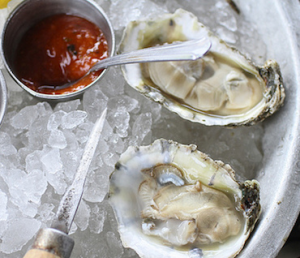
New Book Is a Great Guide for Local Lovers of Oysters, Ecology and History
• By Gregg MacDonald/Fairfax County Times, Oct 17, 2016
At first glance, one might mistake the Chesapeake Oyster Lovers’ Handbook—by Susan Elnicki Wade and Bill Wade—as nothing more than a guidebook to restaurants that sell Chesapeake oysters. But in fact it is much, much more. It is a literary pearl that actually tells the story of one of the area’s greatest environmental triumphs—the cleanup of the Chesapeake Bay.
According to the authors, the inspiration for the book came from a New York City businessman who thought Chesapeake oysters were “too salty, nearly extinct, and grown in polluted waters.” Wanting to educate the public about their favorite maligned bivalve, the Wades wrote a book that is part history, part oyster-eating tips, and part tour guide to Washington D.C., Maryland, and Virginia oysteries.
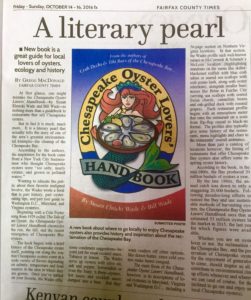
Beginning with a Cole Porter song from 1929 called The Tale of an Oyster, the Chesapeake Oyster Lovers’ Handbook chronicles the rise, the fall, and the recent resurgence of Chesapeake Bay oysters. The book begins with a brief history of the Chesapeake oyster itself, pointing out along the way that Chesapeake oysters come in a wide variety of flavors depending on salinity, temperature and food sources in the area in which they are grown. Once you’ve settled on your favorite, the Wades offer some condiment suggestions—beyond just the usual cocktail sauce, Tabasco or lemon. The Wades serve up oysters with olive oil, salt and pepper, horseradish or even the Slurp ‘n Burp—oysters, hot sauce and cocktail sauce dumped into a beer. But they warn readers off other options, like drawn butter, since cold oysters make butter congeal.
The main focus of the Chesapeake Oyster Lovers’ Handbook, however, is its descriptions of local oysteries in Maryland, Virginia and Washington D.C., including a 36-page section on Northern Virginia locations. In that section, the Wades profile such well-known names as McCormick & Schmick’s McLean location (highlighting standouts on the menu like skillet-blackened redfish with blue crab salsas or seared sea scallops with crab potato hash, along with oyster selections), alongside smaller businesses like Brine in Fairfax City (serving sea scallops with seared Swiss chards, cannellini beans and oak-grilled duck with roasted grapes). Each restaurant profile begins with an atmosphere meter that rates the restaurant on a scale from flip-flop casual to black-tie formal. The profiles also typically give some history of the restaurants, menu highlights and clues to the restaurants’ overall ambiance. More than just a catalog of locations however, the listing of restaurants that offer Chesapeake Bay oysters also offers some inspiring oyster history.
According to the book, in the mid-1800s, the Bay produced 20 million bushels of oysters a year. By the late 1980s, the annual catch was down to only a staggering 20,000 bushels. Following decades-long efforts to restore the Bay and use sustainable methods of harvesting oysters, the Chesapeake Bay Oyster Lovers’ Handbook says that an estimated 53 million oysters hit the market in 2015, the last year for which figures were available.
Whether you are an oyster lover or not, the reclamation of the Chesapeake Bay, and the preservation of Chesapeake oysters for the enjoyment of generations to come, should inspire us all to contribute to environmental clean-up efforts whenever and wherever we can (and of course, for those inclined to go out and enjoy some local Chesapeake oysters).


New book charts Chesapeake Bay oysters, restaurants and raw bars
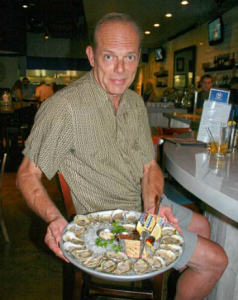 Whether you're a full-blown oyster lover or still a little unsure about the “other” shellfish of the Chesapeake Bay, the new “Chesapeake Oyster Lovers' Handbook” is a handy guide to exploring and enjoying bivalves of the Bay.
Whether you're a full-blown oyster lover or still a little unsure about the “other” shellfish of the Chesapeake Bay, the new “Chesapeake Oyster Lovers' Handbook” is a handy guide to exploring and enjoying bivalves of the Bay.
Along with profiles of more than 120 oyster houses and raw bars in Maryland, Washington, D.C., and Virginia, authors Susan Elnicki Wade and Bill Wade also include stories and interviews with industry insiders, a little bit of history and education, a map of oyster growing regions, and a handy index and taste chart.
The meat of the pocketbook-sized 352-page book is a guide to restaurants and raw bars that carry fresh, local oysters year-round, organized by state and then region. For Maryland, that includes Baltimore, Northern Maryland, Annapolis and Eastport, DC's Maryland Suburbs and Southern Maryland, and the Eastern Shore.
“The Chesapeake Bay is experiencing an oyster boom time,” Bill says. “Thanks to new oyster-growing techniques, the bivalve population is escalating and is available year-round, which debunks the myth that they're only eaten in months with the letter 'R.' As a result, exciting new oyster houses are popping up at an astonishing rate around the region.”
While many establishments serve oysters, the Wades focused on places that  incorporate Chesapeake Bay oysters as part of their identity. A restaurant may list multiple brands on its menu or highlight different ones each week on a chalkboard, Susan explains. A shucker on staff and an oyster bar also show commitment, as does serving oysters year-round.
incorporate Chesapeake Bay oysters as part of their identity. A restaurant may list multiple brands on its menu or highlight different ones each week on a chalkboard, Susan explains. A shucker on staff and an oyster bar also show commitment, as does serving oysters year-round.
Readers will encounter expected establishments, but are likely to discover several surprises as well. In Annapolis, for example, Susan says many oyster fans will think of O'Brien's Oyster Bar and Restaurant, but points out that Blackwall Hitch and Boatyard Bar and Grill in Eastport may be a bit more unexpected.
“Blackwall Hitch is really into oysters,” Susan says, citing a huge oyster display and an oyster bar in the back of the restaurant. And while patrons of the Boatyard easily notice the big bar at the front when they enter, you have to walk around to the back of the restaurant to find the big raw bar and ice-filled cases with signs noting daily selections.
Diners will appreciate each entry's “Atmosphere Meter,” which rates the establishment on a scale from casual to formal. Profiles tell why a location made the list, what to expect, and a bit of a story as well as photos.
Stories from the Chesapeake Bay oyster industry and culture
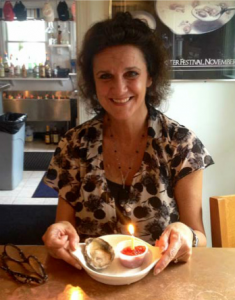 But don't think “Chesapeake Oyster Lovers' Handbook” is only a listing of places to eat oysters. Oyster enthusiasts — and those new to slurping the Bay bivalves — will learn about the rise and fall — and rise again — of the Chesapeake Bay oyster and its cultural ties to the area.
But don't think “Chesapeake Oyster Lovers' Handbook” is only a listing of places to eat oysters. Oyster enthusiasts — and those new to slurping the Bay bivalves — will learn about the rise and fall — and rise again — of the Chesapeake Bay oyster and its cultural ties to the area.
From the start the book was supposed to be more than a guidebook. “We wanted to put some of the soul of the Chesapeake Bay into it,” Susan says. “We didn't want it to be straight data,” which explains the Pearls of Wisdom section that includes stories and articles by experts in the oyster industry and those who celebrate the influence of the oyster, including the Eastport Oyster Boys.
Kevin “Brother Shucker” Brooks explains why the Annapolis-based music group incorporates oysters in its name and song-writing. Dylan Salmon of Dylan's Oyster Cellar in Baltimore gives his inside tricks and tips to enjoying oysters, including what to choose as toppings — and not. And Nick Schauman of The Local Oyster in Baltimore relates “a trip down memory lane” with oysters.
The introductory section also explains the creative seed for the book: an oyster taste test in New York City during a moms' trip where Rappahannocks from Virginia won hands-down among Northeastern oyster fans — and their surprise based on the misconception that Chesapeake Bay oysters weren't up to par.
That event led to Susan and Bill's desire to produce this book to “help the public understand the Chesapeake Bay oyster,” Susan says, as well as “to show you where to go and what to eat.” It also complements the authors' other book, “Crab Decks and Tiki Bars of the Chesapeake Bay,” which is in its fourth edition.
Charting the different Chesapeake Bay oyster brands and tastes
To help oyster lovers and newbies navigate Chesapeake Bay selections, a third section includes a list of more than 70 Maryland and Virginia oyster growers and the brands they produce. A map of growing zones divides the Bay into 13 zones, with a salinity chart and taste chart to help explain the different brands' tastes — from sweet and buttery to briny — allowing users to easily order in restaurants based on their preferences.
While that may sound a bit complicated for the user, it's really not. The alphabetical taste chart makes it easy to look up each brand to see its salinity range and taste description.
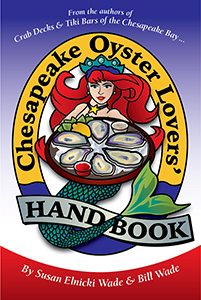 The more than 100 brands of Chesapeake Bay oysters all come from one species. What makes them different is mainly where they are grown, Susan says, along with some other variations. At the top of the Chesapeake Bay, more freshwater flows into the oyster so its saltiness or salinity level is really low, Susan explains. In general, the lower the salinity, the more buttery the taste. At the bottom of the Chesapeake Bay or in the ocean is where oysters are the saltiest, such as the Chincoteagues.
The more than 100 brands of Chesapeake Bay oysters all come from one species. What makes them different is mainly where they are grown, Susan says, along with some other variations. At the top of the Chesapeake Bay, more freshwater flows into the oyster so its saltiness or salinity level is really low, Susan explains. In general, the lower the salinity, the more buttery the taste. At the bottom of the Chesapeake Bay or in the ocean is where oysters are the saltiest, such as the Chincoteagues.
Oyster lovers who want to use the book to explore the different Chesapeake Bay brands should try them “naked,” Susan recommends. “Don't put any cocktail sauce or lemon on a few at first. This gives you the subtlety of the flavor without disguising anything.”
A little nervous about eating oysters? “Try them fried at first,” Susan says, although be sure it's at a restaurant that just dusts them with a little flour and flash fries them. “A good oyster house will not overcook them. Fried oysters help acclimate the mouth to the taste, but you're not eating them raw,” she says.
One last tip from Susan: Make sure the oysters are fresh.
BYT Interviews: An Oyster Expert
Bill Wade and Susan Elnicki Wade may not be professional oyster growers or shuckers, but they certainly know what they’re talking about. They’ve been spending most of their free time recently living the dream, researching the oyster restaurants, bars, and dives, that specialize in the delicious Chesapeake oyster for their new book The Chesapeake Oyster Lovers’ Handbook.
From strip malls in Virginia, to the nicest white linen restaurants, the Wades have been immersing themselves in the oyster word, diving into it’s historical, agricultural, and economical relevance. Now experts, I called them up to chat about their favorite spots, figure out how to tell good oyster bars from bad ones, laugh about the aphrodisiac myth, and in general badger them with my stupid questions. They were great sports.
What inspired you to write the book?
Susan: I don’t know if you knew, Kaylee, but we also had a series of books called Crab Decks and Tiki Bars of the Chesapeake Bay?
Yes, I heard about those!
Susan: That’s our original project and we started that about… four years ago?
Bill: Five years ago.
Susan: Yes, five years ago. A friend of ours said, “Why don’t you guys write a book, you’re always going up to the Chesapeake Bay?” That became our first book. We had a Maryland edition and a Virginia edition… and this was sort of born out of that. Out of our travels and seeing how oyster bars were popping up everywhere. Thanks to the new aqua farming they’re more plentiful, they’re available year round. So we thought, we should put this into a book, and that’s what sparked us.
Bill: Yeah, with crab decks, you think of summer, and with this one you get to complete the cycle. Year round food out of the Bay. So it kind of came because we were just bopping around so much. In order to get the books done we would have to do a lot of off season investigation on crabs, and we were just running into the oysters over and over and over again. Then oyster festivals… And then we got more immersed in it and started meeting the oyster growers, and then we started meeting the shuckers, and before you know it, we were learning a lot about it and it falls into line with the Crab Decks book.
Susan: Crab decks are such a traditional Maryland thing, so we gravitated towards that because Bill is from Maryland. He grew up there and his parents have a boat on the Bay, so it was a part of his childhood. The oyster thing became fascinating to us because there are so many possible components. Of course they taste good, and they’re good for you, but on the environmental side as well, they’re a really an important factor in replenishing the waters of the Bay. They’re little filter feeders. Weird fact: One little oyster can filter fifty gallons of water in a day. It’s like a keg of beer a day. It’s amazing. Then we got even more interested, not that we’re environmentalists per se, but there’s so much good that’s happening here and it’s really booming.
Bill: There are economic benefits too. Dead water, there wasn’t really anything coming out of specific little creeks and all of a sudden they’re bringing a million oysters a year out of a little tiny creek and selling them and giving people jobs. We really didn’t see the oyster houses popping up, probably because they couldn’t really supply enough to them and now, holy hell, we have a whole book of more than a hundred, just in the area. Now they have a guaranteed supply of oysters coming out because oyster farmers are growing them.
Why have oysters becoming so popular over the last couple of years?
Bill: I think they finally got the farming part right on a grand scale. I think, for a while there, they were dabbling in it, and they got a little bit out, and then they figured out how to get a little bit more out, and then others started copy good aqua farming practices. Then also, finally, Maryland government started making it a lot easier to get licensed to do so. Prior to the administration that just ended with O’Malley, there was, I think, five or six different agencies a Marylander who wanted to grow oysters had to go through to get licenses. It was really prohibitive. They streamlined that and all of a sudden, at least the Maryland growers, started exploding. Virginia was well ahead of Maryland in that regard.
Susan: I have another thought, just a different spin on it. I’m more the foodie here and I think everything old becomes new again. You know that phrase? Chesapeake oysters in particular, since the 1800’s have been regarded as some of the finest oysters in the world, and it wasn’t until the mid 20th century when they were over harvested, and the area became polluted, and disease ravaged them, that they got a bad reputation. With the aqua farming, there are all of these positive attributes, like cleaning up the water, so they’re safe to eat, but there was a time when people were dubious about it. If you’re to go to a restaurant now, and it cracks me up, you’ll see deviled eggs, scrapple, these things that my mom used to make. It’s a very 50’s thing, like tiki has come back again. Sometimes we reach back a generation or two and see what they were doing and I think a little bit of that is happening with the oyster bar. Many of them of them you walk into and there’s… not this Gatsby feel… because they’re all different, but there’s just something so decadent about sitting down with the silver tray and the ice and there’s such a ritual to trying a little cocktail sauce, you know? It’s a little bit of a throwback thing.
Bill: Back in the day my mom would go into a restaurant and say, “I’d like a white wine.” No one asks that anymore. You ask for a specific kind or a specific vineyard. Oyster growers are jumping on that as well. Every little creek, every little indentation on the Bay, tastes a little different for each oyster, there’s a little different salinity, or a little different temperature, a little bit different phytoplankton, so that’s made it fun.
Susan: And oyster growers are really capitalizing on that as well. A lot of them are young or are in other careers, so they name things like Sweet Jesus or Hidden Pleasure, so they make it kind of fun and sexy to want to eat oysters again, so I think that’s been part of it.
That’s so funny.
Susan: I know, I know. I love looking through some of the brand names. They are so hysterical.
This is a question I was going to ask you later, because it’s silly, but do you think people actually buy into the whole aphrodisiac thing?
Susan: Well… [Bill laughs] I think they do. I’ve read a couple of different things about it. There are nutrients in oysters that have been scientifically shown… well they can kind of help men get their groove going. I’d have to double check that for you, but there are true health benefits. Plus there’s history, in the Roman times they would have orgies and eat oysters. It’s partly because it looks like a girly thing and you have to open it up.
Bill: Mussels look more like a girly thing than oysters and they don’t say that about mussels.
Susan: I don’t know.
Bill: I think there’s very thin evidence, but why not perpetuate the myth because it’s more fun to do that?
Susan: Is there truth to it? I think the jury’s out but some say. It’s certainly better than eating a cheeseburger.
What sets Chesapeake oysters apart from other varieties like Blue Points?
Susan: In the Chesapeake Bay there is only one species of oyster, Crassostrea virginica, but they taste different depending on where they’re grown and what they absorb from the waters. It’s called a merroir, with wines it’s called a terroir, the grapes taste different depending on the soil they’re grown in. As you go up the East Coast there are other species, but it’s primarily the East Coast oyster from Canada, all the way from the Northern Atlantic, all the way down to Florida and even in the Gulf. It’s pretty much the same species. It’s not until you go out to the West Coast that you see some different ones. It is the indigenous species of the North East.
Bill: You can imagine how a Canadian climate and its waters would produce a different tasting oyster then here.
Susan: And Bill did a really cool thing in our book. We devised a map that charts out the taste, because a lot of it is based on salinity.
Bill: I should back up and say, we thought about doing every oyster there is, but we only had so much time to do this, so we concentrated on our specialty, which was already the Chesapeake Bay. Since it’s exploding we were kind of ahead on the curve on what’s going on here. What I did is I took the Bay and divided it into 13 oyster growing zones and I did that by examining where oysters are being grown currently as well as salinity levels that vary among the Bay I’ll often realize where the fresh water is coming off of a major river.
Susan: Let me just make one thing a little clear, the Bay, at the top of the northern part has the Susquehanna river and freshwater flowing into it. Those oysters grown near the top, are less salty, less briny because the salinity levels in the water is lower. Then as you travel down south and into mouth of the Bay where the Atlantic waters can flow in, the salinity level is higher. So that’s why they have a saltier taste. That’s why Chincoteagues are really briny. They’re right out on the Atlantic. If you look at Barren Island oysters that are grown around Hoopers Island, which is way north of that, those are going to be fresher and more buttery. That’s what Bill’s map did. He made you look at the Bay from north to south and see how as the salinity grew, the richer, brinier, taste came out in the oysters. It’s just a personal preference. I like the buttery ones of the north and Bill likes the briny ones of the south.
Bill: Yeah, I like them all, but this is one of the primary ways they do taste different. Even from creek to creek, if that makes any sense. So I divided the Bay into various growing regions and gave a general taste profile for each region so folks could get an idea. I think one of the fun things we did is create a taste chart. We took all the brands that we could locate, and it was quite a few, I think it was a hundred, and when we could get an exact description of what that brand tastes like directly from the grower, we included it. Otherwise we included a description standard from that region. So our idea, is that if you go to one of the oyster houses listed, and you see a menu, and you see the various names of these oysters and you have no idea what it means or what it’s going to taste like, in theory you open up the back of the book and can read and say, “Oh, okay, I’d like to try this one.”
Is it possible for a novice, someone who is just dipping their toe into the oyster world to tell these different flavors? Or is it something you wont notice right away?
Susan: From the first time, you can tell. One time we were out down the York river and the bartender said, “Let me show you how to really taste oysters.” and he picked one from the north, then one that was farther south, and then one that was like Chincoteague south, and took us on this tour going from briny to medium to salty. That was the first time we went, “Dang, this really is different.” We became after that, not obsessed, but really curious to explore the differences in flavors. But the oyster growers sometimes get really goofy when describing them. Just like wine people, and it’s so goofy when you read something like “the metallic taste and finish,” who wants to eat something metallic? Don’t use that word!
Bill: Yeah, it’s something that I really don’t understand… but the uninitiated can certainly immediately tell. You go to two different regions and the uninitiated will be able to tell the difference.
Susan: I also have noticed now at oyster bars that the staff, in particular if you have a shucker, they’re really excited about it and they love doing what this guy did to us for every customer that comes in. If you go down to Union Market, to the Rappahannock oyster bar down there, they only carry three, and they’re all Rappahannock, but each one is different and they love explaining it to you. So I think even a novice can come in and get initiated in these oyster bars and it’s kind of fun. You’re exploring something new.
As a novice, how can you tell the oyster bar you’re walking into knows what they’re doing?
Bill & Susan: BUY OUR BOOK! [Laughter]
Susan: Buy our book, that will tell you. We really screen them out… but by the way, they are very seriously regulated now so the safety is there. Second of all, if you’re ever out there’s a little tag that each oyster bag is supposed to have, if you ever buy them at a farmers market, look for that tag. It should have a date, where it was grown, and what company grew them. They’re really proud of those tags. By and large it’s no different than going to get sushi. You can tell if a restaurant is funky.
Bill: It’s not just a question of safety… you know one of the things that happened to us while we were pursuing this book, we go into a place and we say “Do you carry oysters?” they say yes, we ask what kind of oysters they carry and they say, “Um… Chesapeake oysters…” and we would just turn around and walk out and say, this is not the kind of place we want in our book. What we want in our book are not those that just happen to carry them and they don’t know what’s on that tag, instead they’re the ones that are proud to promote the variety they’re carrying and they know a little bit about it.
Susan: I found myself becoming a little militant when people tell me they’ve had Chesapeake oysters and I ask them what kind and they say, “Blue Points!” Those are not Chesapeake oysters, Blue Points are from Connecticut. And so I sound a little snobby… but I think if they try and sell you and say Chesapeake oysters are all the same, then you’re probably not in a place that’s really specializing in oysters and that was part of our criteria for the book. We wanted to make sure we were sending people where they can get oysters year round and the places that were serving them knew what they were doing, and you could get a couple different ones to try.
Whats your favorite variety of oyster?
Bill: In the book, we included oysters from the Atlantic, because there are so many grown on the barrier islands of Virginia or Maryland. Those are labeled a generic term, Chincoteague, even though there are a number of growers near Chincoteague Island. I tend to like those because they are salty. The saltier the better.
Susan: Some of the salty ones make my eyes run. I don’t like them they’re just a little too intense for me. Maybe I’m a wuss… I tend to like the buttery, cleaner tasting oysters. I really do hate naming names. It’s like saying I like my older son better, and I don’t, but if I had to I’d probably say Barren Island. I really like those.
Bill: Or the ones coming out of the Western Shore rivers. Like the Patuxent, or the York, or the Rappahannock. I think she likes more of the river oysters.
Susan: That’s true, but I think I would be more general about it. I just like the buttery, crisp oysters. I still like putting cocktail sauce on mine, although you should try them naked because then you can really get the taste. And I’ll take a fried oyster any day. I just think the crunch is so good. I could eat them forever.
I’m going to ask you another favorite question, so bare with me, but where is your favorite place to get oysters in DC?
Bill: Yeah, we have a favorite. It’s Pearl Dive. They really know what they’re doing and they’re very knowledgeable and they have a variety of oysters come through, and they prepare it in so many ways. I can’t tell you how many times we’ve gone there, ordered a plate of raw ones, tastes all the varieties, and then ordered an oyster entree too.
Susan: Their fried oysters are so freaking good. That little sampler, you get three on top with the chorizo and sweet potato, it’s awesome. There’s another one that I’ve come to love and that’s Pop’s in Adams Morgan. You feel like you’re in any kind of diner and their oysters are fabulous.
Bill: Yeah, you’ve got to go. And there. you can get dollar oysters 2:30am after the bars close.
Susan: I don’t know how some people do that… because if you’re going to throw up, all those oysters ugh. But Pop’s is a great one. It’s so fun, it’s so different, it’s not the white linen, tiny silver fork kind of place, and that’s one of the things I love about our book, we discovered some of the strangers places that were selling oysters because we didn’t want them all to be McCormick & Schmidt or Oceanaire where you’re paying $3 an oyster. We wanted to find the little out of the way places. That’s another fun thing, not only did we find interesting restaurants, but we found interesting places. We find them in strip malls next to a Chuck E. Cheese or an H&R Block.
Bill: And then we go in and they’re great.
Susan: They are!
Bill: You wouldn’t have any idea you’re in a strip mall.
Susan: There are places out in the suburbs where I normally get the heebie jeebies going out to, but they were really fun places. So sometimes if you’re stuck out at a kids soccer game and are done with the suburb life, there are tons of oyster bars around that are really good places to go.


